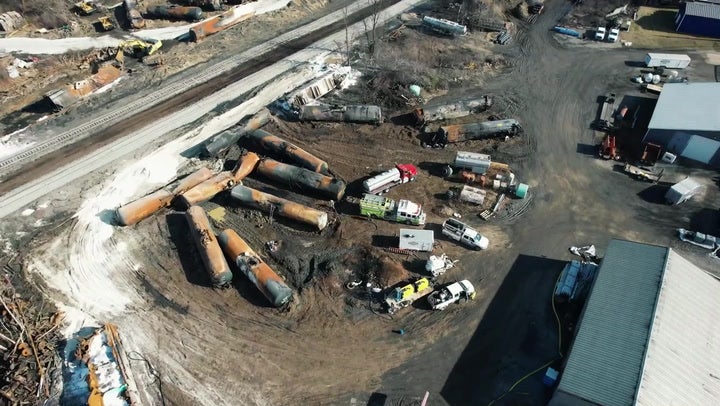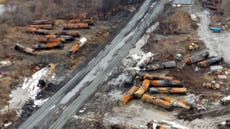Ohio town shrouded in toxic chemicals still seeks answers after train crash
In East Palestine, Graig Graziosi talks to residents affected by the derailment while Josh Marcus in San Francisco considers the looming political fallout


A train horn sounds long and loud, shattering the quiet of East Palestine.
“It’s almost insulting,” says Vincent Greene, one of five lawyers visiting to offer advice to worried residents facing an emerging environmental and health catastrophe.
Only 12 days have passed since a huge train derailment and subsequent venting of hazardous gas into the air, yet trains have restarted, once more carrying hazardous cargo through the middle of the small Ohio town.
For local people, a similar return to normality feels out of reach.
Much remains unknown about the dangers posed by the spilled chemicals, but many residents have complained of headaches and irritated eyes, and noted that chickens, fish and other wildlife have died off. Yet health officials insist this is a safe place to be.
On the evening of 3 February, a 150-wagon Norfolk Southern train derailed after a ball bearing overheated.
The resulting wreck left the wrecked train sprawled across Taggart Road. Five wagons were carrying vinyl chloride, a hazardous chemical used in the production of PVC piping. It is also highly flammable and can contribute to a rare and aggressive liver cancer.
Fires at the scene of the crash threatened to ignite the freight cars, forcing Norfolk Southern and the state and local authorities present at the scene to vent and burn the gas to prevent a massive explosion from showering the surrounding mile of village in shrapnel and poison. A massive black pillar of toxic smoke rose into the air.
Residents noticed and began asking questions. Were they in danger? Could they drink water from their wells? Would Norfolk Southern help them?
The mayor, Trent Conaway, convened Wednesday’s meeting. Residents believed Norfolk Southern would be on hand to answer questions — and likely take a bit of a verbal licking — from the audience.

By Wednesday morning, the meeting had changed at the request of Norfolk Southern to be less of a ‘town hall’ and more of an open house, where residents could visit tables manned by local and state officials to have questions answered.
Then the train company told Mr Conaway they simply weren’t coming at all. “Norfolk Southern was invited, they pushed the table thing, then told me in a letter they didn’t feel safe and wouldn’t be coming,” he says.
By 7pm, a line of concerned residents stretches from the doors of East Palestine high school’s auditorium down West Grant Street.
As residents are slowly allowed in, some further back in the line are they won’t get make it inside. “There’s a mile-long line, and it’s only going until 9pm,” says Nicole Douglas, sanding more than a block away.
Sean Hutton, Ms Douglas’s partner, says the community has been relying on Facebook groups to keep each other informed but have been getting conflicting answers to their questions.
“This isn’t what we came here for!” one resident shouts from the middle of the auditorium’s main floor.
With hundreds of residents still being kept outside, hundreds inside demanding a town hall and a gaggle of reporters looking on, Mr Conaway decides to toss Norfolk Southern’s open house idea in the dumpster and grabs a megaphone.

Residents ask about air and water monitoring; the EPA says it would continue to monitor for as long as necessary, but that thus far it hadn’t detected anything worrisome in drinking water or the air.
Ohio Department of Health Chief Medical Officer Dr Bruce Vanderhoof explains at length why residents might smell the gas, what their risk factor was from exposure to volatile organic compounds, and why it seems as though – despite 3,500 fish dying in Columbiana County streams after the accident – water and air contaminant levels appear to be relatively safe.
“I don’t know what to do to provide further assurances,” Dr Vanderhoff insists.
The evening continues with general scepticism. “We’re all very afraid,” a woman calls out from the stands, to applause.

Kayla Miller, who has been making TikTok videos to share her experiences in the aftermath of the train derailment, says fish are continuing to die in her stream. Staci Reed’s son is in hospital with rashes despite levels of air contamination being within acceptable ranges. Nicole Douglas wants to know why federal assistance from FEMA has not arrived.
“All they sent us was a bunch of police,” she says, noting the huge number of officers at the auditorium.
All Mr Conaway can give is sympathy and limited assurances. Residents are angry at how fast the trains still come through East Palestine, but he tells them it is out of his control. Residents are frustrated with water testing, but he says this is done by the EPA, not him.
“I’m a mayor of a town of 4,700 people,” he said. “If you think I can fight against a railroad or fight against the EPA or fight against anything like that, you’re crazy.”
Who is to blame?
While the immediate cause of the derailment, according to the National Transportation Safety Board’s preliminary investigation, was an overheated wheel bearing, the deeper reasons for the crash are more complex.
Some, like Steven Ditmeyer, a former top official at the Federal Railroad Administration, argue the federal government hasn’t done enough to champion Electronically Controlled Pneumatic brakes, a braking system that would update existing rail brake technologies, which date back to the Civil War era in some places.
“Would ECP brakes have reduced the severity of this accident? Yes,” Mr Ditmeyer told Lever News.
In 2015, the Obama administration passed a rule requiring ECP brakes on some trains carrying hazardous materials, but ignored the NTSB’s request that the rules apply to all such trains. The Trump administration, lobbied by rail carriers including Norfolk Southern, the company which operated the train that derailed in Ohio, rescinded the rules entirely.
Sherrod Brown, US Senator for Ohio, argues the GOP carries the share of the blame for the rollback.
“We are concerned that the Trump administration rolled back some of the safety rules and some of the railroad safety and worker safety rules,” he tells The Independent, adding, “I mean, every chance Republicans get they weaken worker safety rules, they weaken and weaken environmental rules. They weaken consumer protection rules. So we want to know if we’ve got to fix that. But that doesn’t help East Palestine now.”
The rail industry, meanwhile, argues such braking technologies are still unproven. Association of American Railroads spokeswoman Jessica Kahanek told USA Today ECP brakes have a “significant” failure rate.
Others blame labour conditions at the nation’s rail carriers for causing declining staffing and lower safety standards.
“It speaks to the conditions on the railroad,” Vermont Senator Bernie Sanders tells The Independent. “I think some of the workers, they will tell you that they thought something like this was inevitable and that we have to deal with a situation where in the last six years 30 per cent of that workforce was cut back."
Facing competition from ground freight, rail carriers, including Norfolk Southern, have embraced a practice known as precision scheduled railroading (PSR), which centres on maximising the utility of each individual rail car rather than considering whole trains as a single unit.
In practice, PSR has meant longer trains, overseen by fewer workers, sometimes with loads dangerously weighted towards the back of rail convoys, according to railway unions.
“The short-term profit imperative, the so-called ‘cult of the Operating Ratio’ – of NS [Norfolk Southern] and the other Class 1 railroads – has made cutting costs, employees, procedures, and resources the top priority,” Railroad Workers United told The New Republic.
Norfolk Southern alone has lost 40 per cent of its workforce in recent years, per SEC filings.
What is the federal government doing?
Politicians from both parties have argued the Department of Transportation, helmed by Pete Buttigieg, doesn’t seem to be doing enough to prevent further tragedies.
“We need Congressional inquiry and direct action from Pete Buttigieg to address this tragedy,” Minnesota Democrat congresswoman Ilhan Omar, posted on Twitter on Monday.
“Fully agree,” Texas Republican senator Ted Cruz wrote in response.
In response, Buttigieg said: “We could start by discussing immediate steps Congress could take to address rail safety and reduce constraints on USDOT in this area. Give us a call, we can do some good work.”
Mr Buttigieg has defended the Biden administration’s work on the rail system, pointing to “historic investments in rail safety” coming through the Bipartisan Infrastructure Law, as well as a round of grants in June providing $120m for rail safety.
“How did this happen?” Ohio Senator JD Vance, a Republican, tells The Independent. “How do you prevent it from happening in the future?”
“We have to put our eyes on this problem, learn from it, and make sure that regulatory and administrative structure is able to protect against it,” adds Senator Ed Markey of Massachusetts, a Democrat.






Join our commenting forum
Join thought-provoking conversations, follow other Independent readers and see their replies
Comments